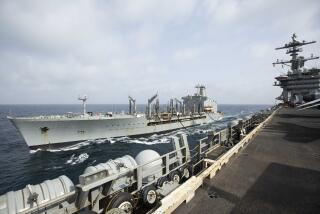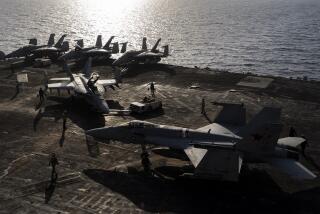Navy Grounds 90 Planes Plagued by Faulty Engines
The Navy has grounded 90 light attack jets on as many as 11 aircraft carriers and at two flight training centers in California and Florida after the discovery of faulty turbine blades that caused two recent crashes and could be linked to as many as five others, The Times has learned.
Orders to halt flights of the A-7E Corsair II were sent Friday from Washington to aircraft carriers around the world, according to Navy spokesman Lt. Peter Johnstone in Washington. The orders included instructions that the planes were to be used, at risk, for emergency or wartime purposes only.
Johnstone said it will take âa matter of monthsâ before all of the suspected planes that require new engines are identified and the replacement work completed.
He said the grounding would have âminimal impactâ on Navy operations.
But the deputy director of the Center for Defense Information in Washington said the idling of the A-7E, one of the oldest warplanes in the U.S. fleet and considered the backbone of the Navyâs conventional and nuclear ground-attack force on carriers overseas, could significantly threaten national security.
âItâs a substantial loss of immediate combat capability when you have 90 airplanes grounded out of a fleet of some 200,â said Eugene Carroll, a retired rear admiral.
The engines, built by Allison Gas Turbine Division of General Motors, are failing because of blades that contain unusually high amounts of lead, which cause them to snap off during flight and damage the engines. Allison is working with the Navy to send eight maintenance experts to aircraft carriers around the world to repair engines found to have the suspect blades.
Eight A-7E jets have been lost in crashes this year, six since March 26. Of the eight crashes, two have been caused by the failed turbine blades, one is believed to be linked to the blades and four others are under investigation. In all but one crash, pilots successfully ejected. In the eighth case, not connected to the blade problem, a pilot was killed June 3 in Jacksonville, Fla.
âObsolescent at Bestâ
The Navy is gradually replacing the A-7E, which President Carter described in 1979 as âobsolescent at best,â with new, $32-million supersonic F/A-18 Hornets. The A-7E is expected to be phased out by the early 1990s.
Two aircraft carriers, the Constellation and the Coral Sea, are equipped with the new F/A-18s. The remaining 11 deployable carriers rely on the A-7E for ground attack. The A-7E carries a wide array of bombs and guided missiles and, according to retired military sources, is capable of dropping nuclear bombs.
The Navy would not release the number of planes that it has grounded on aircraft carriers or the availability of replacement engines on board. Johnstone said such information is âclassified.â
The Navy operates 310 A-7E aircraft. Each aircraft carrier has 24 of the single-engine attack planes, bringing the total number of A-7Es on deployable carriers to 244. The rest of the planes are used in training at Lemoore Naval Air Station near Fresno and Cecil Field Naval Air Station in Jacksonville.
A Navy source in Washington told The Times that most of the 90 planes that have been grounded are on aircraft carriers.
Not Enough Spare Engines
Johnstone said the planes on aircraft carriers are being checked for faulty blades and the engines replaced on a âpriorityâ basis. He said it takes about one day to replace an A-7E engine, but the Navy does not have enough spare engines to immediately fix all 90 planes.
The turbine blade problem was first discovered on July 10 by mechanics at a Navy rework facility in Jacksonville who were investigating a June 28 crash of an A-7E.
The faulty blade was sent to Allisonâs Indianapolis offices. A chemical analysis of the blade on July 11 found 70 parts per million of lead--well above the allowable 10 parts per million, Allison spokesman Donald G. OâBrien said.
The high lead content reduces the ability of the blades to endure stress, causing them to crack and set off a sudden string of events that results in engine failure.
âA single blade that can fail will throw your rotor out of whack and have an effect on bearing support,â OâBrien said. âIf that fails, you get vibration and the engine rumbles,â leading to engine failure.
Crash Off California Coast
The most recent crash of an A-7E jet occurred July 13 off the Southern California coast. The plane, based at Lemoore, was flying from Miramar Naval Air Station in San Diego to the aircraft carrier Enterprise when it developed mechanical problems. The pilot ejected and spent 30 minutes in the water before he was picked up by a helicopter from the carrier.
On July 23, Allison notified Navy officials in Washington of problems with the planes equipped with engine type TF41A-2B and gave them a series of recommendations, including conducting thorough examinations of all engines and returning suspect blades to the firm.
âWe suspect something went awry in the original casting of material from which the blades are made,â OâBrien said. âThat is where the excess quantities of lead cropped up. The cause is being sought so it doesnât happen again. It sounds like a crazy, bad batch.â
Carroll, of the Center for Defense Information, said, âThese engines are pulled out and reworked at regular intervals. Someplace at the rework cycle . . . they lost control of the situation. To suddenly start having an old workhorse fail in this fashion is very hard to understand. These problems donât occur overnight.â
A Navy source in Washington explained that the blades were inspected on a random basis before they were installed. He said the high lead content was not detected in those inspections.
OâBrien said the blades were manufactured by Wiggan Alloys Ltd. of England.
Responsibility for Costs
Navy officials said that responsibility for the cost of the repairs is being negotiated.
A congressional source said he was told Monday by Navy officers that 35 or 36 airplanes had been grounded.
âThey donât see it as a big deal,â said the source, who added that the Navy officers saw no strategic significance in the grounding.
But a Navy source who spoke on the condition that he would not be identified said that Navy officials are taking the situation seriously.
âWhen planes are falling out of the air, itâs serious,â the source said.
Navy aircraft carriers are stationed in the Carribbean, the Indian Ocean, the western Pacific Ocean, the Atlantic Ocean and the eastern Mediterranean Sea.
âThe schedule is to do it as soon as we can,â said Allison spokesman OâBrien. âWherever the hell there is a suspect engine in an aircraft, weâve got to get to it.â
Two weeks ago, when asked by The Times about reported problems with A-7E engines and whether a grounding of the craft was possible, Johnstone said, âNothing is being contemplated.â
He said then that âweâve had an ongoing engine modification program for some timeâ involving high-pressure turbine blades, but that no unusual incidence of accidents had been reported to the Pentagon offices with which he had checked. He said âno meetings or panelâ had been arranged on the A-7E.
After a series of high-level discussions in Washington with Allison, the Navy decided to issue the grounding order on Friday.
The Air National Guard has 57 A-7E planes based near Oklahoma City that may have faulty blades, OâBrien said. Those plane have also been grounded.
The attack planes, which were first sold to the Navy in 1968, also were sent to Portugal and Greece in the mid-1970s. But none of the foreign planes is believed to have faulty blades, OâBrien said.
Times staff writers James Gerstenzang and Gaylord Shaw contributed to this story from Washington.
More to Read
Sign up for Essential California
The most important California stories and recommendations in your inbox every morning.
You may occasionally receive promotional content from the Los Angeles Times.










